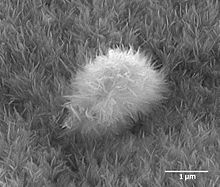CHELATES
The ligands containing two or more
bonding sites are the polydentate ligands. Any class of co-ordinate or complex
compounds in which the polydentate ligands are attached through the two or more
doner atoms to the same central ion forming the one or more rings or cyclic
structure are called chelates.
The polydentate ligands having two or
more doner atom and are able to form many chelates are called as chelating
agent or chelating ligands or chelating groups. Some chelating ligands are EN,
EDTA, oxalate ion etc.
The process by which the formation of
such ring structure takes place with the chelating agent is called as
chelation.
The enhanced stability of complexes with
chelated ligands( polydentate ) for a metal ion compared to the similar
non-chelating ligands ( monodentate ) for the same metal during the complex
formation is called as chelate effect. For example: [Ni(en)3]2+ is about 10 ^10 times stable than [Ni(NH3)6]2+.
The increase in stability of chelate
complexes is due to following reasons:
1.
Due to increase in the linkage sites.
2.
Due to formation of one or more rings.
3.
The entropy and enthalpy change for the chelate
complexes are greater than non-chelated complexes.
chelate with one chelate with two chelate with three
ethylenediamine ligands ethylenediamine ligands ethylenediamine ligand
In the two structures on the left, the bonding capacity of the Ni2+ ion is completed by water molecules. Each water molecule forms only one bond to Ni2+, so water is not a chelating agent. Because the chelating agent is attached to the metal ion by several bonds, chelates tend to be more stable than complexes formed with monodentate ligands such as water.
Porphine is a chelating agent similar to ethylenediamine in that it forms bonds to a metal ion through nitrogen atoms. Each of the four nitrogen atoms in the center of the molecule can form a bond to a metal ion. Porphine is the simplest of a group of chelating agents called porphyrins. Porphyrins have a structure derived from porphine by replacing some of the hydrogen atoms around the outside with other groups of atoms.
One important porphyrin chelate is heme, the central component of hemoglobin, which carries oxygen through the blood from the lungs to the tissues. Heme contains a porphyrin chelating agent bonded to an iron(II) ion. Iron, like nickel, can form six bonds. Four of these bonds tie it to the porphyrin. One of iron's two remaining bonds holds an oxygen molecule as it is transported through the blood. Chlorophyll is another porphyrin chelate. In chlorophyll, the metal at the center of the chelate is a magnesium ion. Chlorophyll, which is responsible for the green color of plant leaves, absorbs the light energy that is converted to chemical energy in the process of photosynthesis.
Another biologically significant chelate is vitamin B-12. It is the only vitamin that contains a metal, a cobalt(II) ion bonded to a porphyrin-like chelating agent. As far as is known, it is required in the diet of all higher animals. It is not synthesized by either higher plants or animals, but only by certain bacteria and molds. These are the sources of the B-12 found in animal products. Because vitamin B-12 is not found in higher plants, vegetarians must take care to include in their diets foods or supplements that contain the vitamin.







 where h= planck constant
where h= planck constant 
